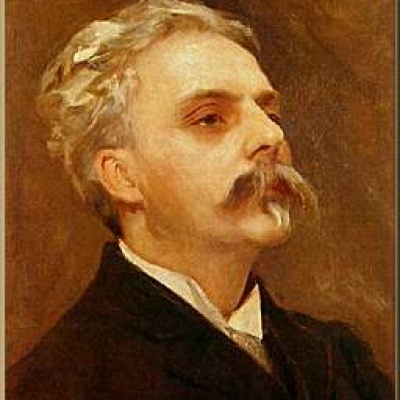
Gabriel Fauré
加布里埃尔•于尔班•佛瑞(Gabriel Urbain Fauré,1845年5月12日-1924年11月4日),法国作曲家、管风琴家、钢琴家以及音乐教育家。佛瑞前承圣桑,后继者则有拉威尔与德彪西;早期与圣桑一同为法国国民乐派奠基,后期在巴黎音乐学院任内力行改革,提拔后进,对于法国近代音乐发展起了轴承的作用。佛瑞的音乐作品以声乐与室内乐闻名,在和声与旋律的语法上也影响了他的后辈。 佛瑞作品的特点拥有许多线条优美的弦律,在每一颗音符的音色上,都集中在寻找最为纯净的声音;而他所创作出来的甜美歌曲也为代代世人所青睐。他的和弦及器乐法相对于古典乐曲来说并没有太大的变革,然而他所拥有的和弦协调性及高超的和声技巧,使他的大提琴奏鸣曲、小提琴奏鸣曲、钢琴奏鸣曲以至于艺术歌曲等等,乐曲内所蕴含的独创性动机,情感表达的内涵之丰富,大大展现了高卢人内心世界的最高之作,倍受世人、后继及当代作曲家的高度赞赏。 When Gabriel Fauré was a boy, Berlioz had just written La damnation de Faust and Henry David Thoreau was writing Walden. By the time of his death, Stravinsky had written The Rite of Spring and World War I had ended in the devastation of Europe. In this dramatic period in history, Fauré strove to bring together the best of traditional and progressive music and, in the process, created some of the most exquisite works in the French repertoire. He was one of the most advanced figures in French musical circles and influenced a generation of composers world-wide. Fauré was the youngest child of a school headmaster and spent many hours playing the harmonium in the chapel next to his father's school. Fauré's father enrolled the 9-year-old as a boarder at the École Niedermeyer in Paris, where he remained for 11 years, learning church music, organ, piano, harmony, counterpoint, and literature. In 1861, Saint-Saëns joined the school and introduced Fauré and other students to the works of more contemporary composers such as Schumann, Liszt, and Wagner. Fauré's earliest songs and piano pieces date from this period, just before his graduation in 1865, which he achieved with awards in almost every subject. For the next several years, he took on various organist positions, served for a time in the Imperial Guard, and taught. In 1871 he and his friends — d'Indy, Lalo, Duparc, and Chabrier — formed the Société Nationale de Musique, and soon after, Saint-Saëns introduced him to the salon of Pauline Viardot and Parisian musical high society. Fauré wrote his first important chamber works (the Violin Sonata No. 1 and Piano Quartet No. 1), then set out on a series of musical expeditions to meet Liszt and Wagner. Throughout the 1880s, he held various positions and continued to write songs and piano pieces, but felt unsure enough of his compositional talents to attempt anything much larger than incidental music. Fauré's pieces began to show a complexity of musical line and harmony which were to become the hallmarks of his music. He began to develop a highly original approach to tonality, in which modal harmony and altered scales figured largely. The next decade, however, is when Fauré came into his own. He was named composition professor at the Paris Conservatoire in 1896. His music, although considered too advanced by most, gained recognition amongst his musical friends. This was his first truly productive phase, seeing the completion of his Requiem, the Cinq Mélodies, and the Dolly Suite, among other works. Using an economy of expression and boldness of harmony, he built the musical bridge over which his students — such as Maurice Ravel and Nadia Boulanger — would cross on their journey into the twentieth century. In 1905, he was named director of the conservatory and made several significant reforms. Ironically, this position gave his works more exposure, but it reduced his time for composition and came when he was increasingly bothered by hearing problems. Fauré's works of this period show the last, most sophisticated stages of his writing, streamlined and elegant in form. During World War I, Fauré essentially remained in Paris and had another extremely productive phase, producing, among other things, Le Jardin clos and the Fantaisie for piano and orchestra, Op. 111, which show a force and violence that make them among the most powerful pieces in French music. In 1920 he retired from the school, and the following year gave up his music critic position with Le Figaro, which he had held since 1903. Between then and his death in 1924, he would produce his great, last works: several chamber works and the song cycle L'horizon chimérique.
